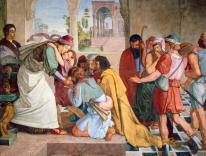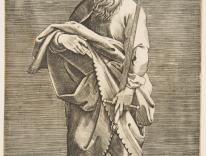Last year, Haley Waldman, an eight-year-old New Jersey girl, made headlines when her first Communion was declared invalid because the wafer had been made of soy flour (New York Times, October 4, 2004). The child suffers from celiac disease, a digestive disorder that makes it unsafe for her to eat wheat. Her difficulty had led a sympathetic priest to substitute the soy host, but when the local archbishop learned of the irregularity, he declared the Communion invalid. Haley’s mother, Elizabeth Pelly-Waldman, told the press, “I don’t want to bash the church, but Christ would not have turned away my child for a medical condition.”
Who is right in this story of conflicting goods: a needy and desirous child and her family, or the local ordinary and the tradition he pledged to uphold? Why does the church insist that only wheat bread is “valid matter” for the Eucharist? In a somewhat analogous situation, why has the church allowed the use of nonfermented wine at Mass for priests and others who are allergic or addicted to alcohol? Might not a similar broadening of the rules apply to those who are allergic to wheat or gluten? As Haley Waldman’s mother seemed to imply, would a father asked by his child for bread give her a stone instead? Perhaps a look at the history and development of sacraments, particularly in light of Vatican II, will shed some light on how church leaders may consider resolving cases like those of young Haley Waldman.
In the Palestine of Jesus’ day, wheat and barley were used in bread. In John 6, barley loaves play a significant role in the remarkable feeding of more than five thousand, a foreshadowing of the Eucharist. Bread made from barley was more common among the poor, wheat being the more expensive grain. As with poor people the world over, whatever food is most available and affordable is what is used. Sometimes grains are mixed, their bulk increased by adding vegetables and herbs.
As members of the early Christian communities began to prosper, their diet improved, followed, no doubt, by their taste. While wheat was the standard at eucharistic celebrations, its use was not formally legislated until the Council of Florence (1439). That this requirement came only after a long, gradual process, and that new insights from modern medicine and biology have helped us realize some people should not be exposed to certain foods, suggest that further theological and canonical exploration may be useful in resolving such cases as celiac allergy. Is a substitute for wheat possible at the Eucharist?
One of the earliest recorded instances related to the validity of the eucharistic elements comes from the second and third centuries. Some early Christian communities were apparently so poor that they could not afford wine. They substituted water (aqua), and came to be called Aquarians or Hydroparastatae. We know little about the group, but its existence is verified in the writings of the early church fathers. Some Aquarians may have substituted water out of ascetical reasons; for others, there may have been theological or political overtones. The movement never gained traction, however, and the issue faded.
From about 200 to 1150, theological treatises on the sacraments were few and far between. Until the Third Council of Constantinople (681), the overwhelming theological focus of the church, both Eastern and Western, was Christological-on Jesus as truly God and truly human. The sacraments were celebrated and a variety of liturgies flourished, as did homiletic and catechetical materials on the sacraments. Theological discussion of the sacraments took place primarily in the context of specific issues, for example, when Augustine and the Donatists contended over the validity of sacraments administered by sinful ministers.
That trend changed in the second millennium. In 1150, Peter Lombard (c. 1100-60) wrote his seminal work, the Sentences. For the first time, the sacraments were considered systematically and their nature analyzed philosophically and theologically. Lombard’s book became a major university text and, following an initial period of controversy, served as a theological standard throughout the Middle Ages. Alexander of Hales, Aquinas, Bonaventure, and Duns Scotus all wrote commentaries on it. Influenced by the thought of Aristotle, these thinkers formulated what came to be known as the classic four-cause approach to the sacraments: You will know it is a valid sacrament when all the “causes” are present. This general understanding of sacramental theology held sway in the West until shortly before Vatican II.
The four causes are: the material cause (for example, water, oil, bread, and wine); the formal cause (the precise words of the minister); the efficient cause (the role of the priest); and the final cause (the conferral of grace). While four-cause sacramental theology became established as the uncontested standard for determining whether (and how) sacraments are validly administered, there remained different emphases and schools of thought on how to interpret these principles in particular cases. Still, when it came to wheat bread as a requirement for the Eucharist, a degree of unanimity prevailed.
In response to the Protestant Reformation, the Council of Trent (1545-63) reiterated the importance of four-cause theology but continued to allow a variety of interpretations (for example, those of the Franciscans and the Thomists). Furthermore, recent scholarship on Trent’s use of the term anathema indicates that the council’s incorporation of the word did not necessarily imply that it was making a formal declaration of heresy. This being the case, we can no longer conclude that the canons established by Trent, and their repetition in later canon law, mean that the use of nonwheat bread is contrary to Catholic doctrine.
Serious questions about the adequacy of the four-cause sacramental theology began to rise in the Roman Church in the middle of the twentieth century with the so-called Nouvelle Théologie. Theologians associated with this movement, such as M. D. Chenu, Yves Congar, Jean Daniélou, and Henri de Lubac, studied the Eastern churches and their theologies, many of which long antedated scholastic four-cause sacramental theolog. There they rediscovered a theory of sacraments that centered on the work of the Holy Spirit rather than on the types of causality. At first, Nouvelle Théologie was rejected by Pope Pius XII, but at Vatican II, its practitioners came to play a pivotal role.
Despite Pius’s resistance to the new theology, he made a major sacramental revision, allowing priests who suffer from alcoholism to use grape juice (mustum) instead of wine in celebrating the Eucharist. In fact, some four-cause theologians severely criticized his stance, even to the point of calling him heretical. The regulation remains in effect today, although Pope John Paul II restricted its use. But if grape juice can be substituted for wine, why can’t soy or rice bread be substituted for wheat bread? If exceptions can be made for the one, why not for the other?
Along with some of the new understandings of sacraments derived from the Nouvelle Théologie, the mid-twentieth century saw the rise of other interpretations that had a profound effect on Vatican II. As found in the writings of theologians like Karl Rahner and Edward Schillebeeckx, these relate to understanding Jesus as the primordial sacrament. This approach broadened the meaning of sacrament and came to see the church itself as a foundational sacrament. Only on this basis, it was argued, can we understand the individual seven sacraments. The approach was a major departure from the traditional four-cause sacramental theology.
Among its many important teachings, Vatican II officially referred to the church as a foundational sacrament. This view opened up an appreciation for the sacraments that takes us significantly beyond the teachings of Trent. It is impossible to explain the sacramental character of either Jesus or the church simply by applying the four-cause paradigm. How can one speak of a material and formal cause of Jesus; how is the church the efficient cause of everything that happens within the church community?
Since Vatican II, in an effort to preserve four-cause theology, some theologians have argued that Jesus and the church are sacraments only in a wider, analogous sense. But this interpretation is not in keeping with the ccouncil’s own documents. Similarly, the 1993 Catechism of the Catholic Church presented a sacramental theology that offers decidedly mixed signals. It retains Vatican II’s understanding of the church as a foundational sacrament, but generally minimizes it. Its first section on the sacraments (1076-1209) presents a Trinitarian sacramental theology in which the Trinity is described as both the source and the goal of the liturgy. What follows on the individual sacraments (1210-1666) pays little attention to the church as a foundational sacrament or to the Trinity as the source and goal of all sacramental liturgy. In this section of the Catechism, each sacrament is treated on the basis of the traditional four-cause understanding. It is as if the initial section had no bearing on the discussion that follows.
These developments indicate that the four-cause theology of sacraments, so prominent since the Middle Ages, is not dead; it continues to exert a profound influence on how the official church thinks and teaches. On the other hand, we have seen that the church’s medieval understanding of sacraments is but one of several ways to explain and interpret sacramental theology. From the viewpoint of history, and in light of questions posed by contemporary pastoral and ecumenical concerns, we can no longer rely simply on a four-cause theology. Nor has the church ever declared that its earliest sacramental understandings are less than orthodox. In fact, these ancient theologies remain widespread and operative in all the Eastern churches. They focus on the Holy Spirit, on the Trinity, on the eschaton, and on the mystical. A leading theologian of the Orthodox tradition, Alexander Schmemann, noted that while Western theology has said much about the validity of sacraments, major questions remain: What, for example, is being made valid in baptism? In the Eucharist? In reconciliation? The Eastern churches are more concerned about what is made valid rather than how. Still, in the West, the documents of Vatican II and even some significant passages in the Catechism have shifted our understanding of sacramental theology significantly.
Recounting these developments is meant to contextualize our current situation and to further our understanding regarding the use of nonwheat bread at Mass. Yet the issues are larger than simply what kinds of bread or wine are suitable for the Eucharist. They have to do with the very meaning of tradition. The four-cause theology of sacraments is but one tradition among several. Its official adoption at the Council of Trent was undertaken in a generalized way and must be seen in light of the apologetic and defensive stances the bishops took to counter the positions of Luther, Calvin, and Zwingli. Post-Trent catechisms, especially those of Charles Borromeo, Peter Canisius, and in this country the Baltimore Catechism, became popular and effective pedagogical tools. Yet their approach relied on the defensive and apologetic four-cause theology of Trent. Fortunately, today, we can see the limitations of that theology. Our understanding has been opened to the more expansive, truly catholic tradition alluded to above.
This in itself does not resolve the specific issue of Haley Waldman and the church officials who have refused to validate her Communion. Still, there exists in scholastic theology a time-honored humanizing injunction: sacramenta propter homines (“sacraments are meant for human beings”). By focusing on sacramental life in terms of the human person, we ought to be able to better take into account the real needs of an eight-year-old child, not to mention a host of others. Sacraments really are meant for people.
Please email comments to [email protected] and join the conversation on our Facebook page.
Share
Previous Story
A Mutual Presence
Next Story
Wild Things

